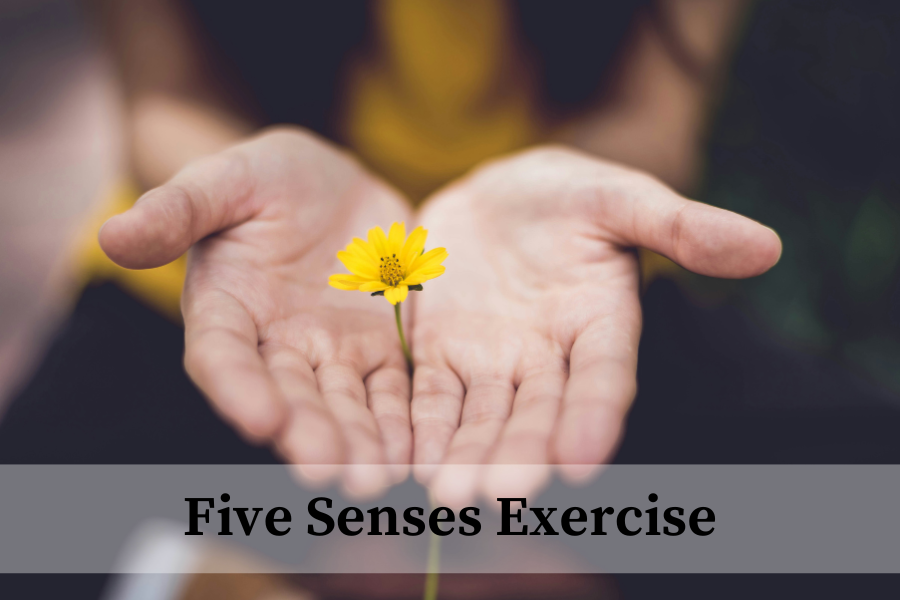Are you looking for a quick and easy way to relieve stress? Then this five senses exercise is for you!
If you struggle with anxiety or racing thoughts, then give this five senses exercise a try! It’s a mindfulness technique that helps to refocus your attention on the present moment so you can return to your day feeling calm and relaxed.
This post will cover the five senses exercise and its benefits, as well as, go over mindfulness and how to practice it.
This post is all about the five senses exercise!
The Five Senses Exercise
1. Begin by taking a comfortable seat with your feet resting on the ground, sit up straight, and lay your palms in your lap or resting on your thighs. You can also lie down if that’s more comfortable.
2. Start to focus on your breath. Deepen your inhale and exhale, noticing the pause in between. Take at least a few deep breaths like this.
3. Begin to look around you. Take in the shapes and colours of different objects. Now, name five things you can see. Try not to judge, just notice. It could be the carpet, your legs sitting in the chair, a bookshelf, or anything else in your field of vision.
4. Now, name four things you can feel. Bring your attention to your body. You may feel your feet on the floor, your hands in your lap, the air on your skin, or your clothes against you. You can also move to touch something close to you.
5. Begin to notice the sounds happening around you. It may be birds chirping, the traffic outside, or a TV playing in the other room. Try to name three things you can hear.
6. Now, name two things you can smell, closing your eyes may help. Maybe it’s the perfume you’re wearing, or the smell of fabric softener on your clothes. Maybe, it’s the trees outside or the scent of fresh paper or books.
7. Finally, name one thing you can taste. It could be toothpaste, your morning coffee, or the last thing you ate.
Now, notice how you feel. Do you feel more relaxed? What sensations in your body have changed? Again, don’t judge, just notice.
The Five Senses Exercise Benefits
There are many benefits to the five senses exercise, including, stress relief, improved emotional regulation, and increased focus and productivity.
Stress Relief
When you’re feeling stressed or anxious, the five senses exercise can help to calm your racing thoughts. It helps to ground you in the present, pulling you from your thoughts and making you feel more relaxed.
Improved Emotional Regulation
By bringing your focus into your body, you get it out of your mind and into the present moment. This helps to improve your body-mind connection and allows you to identify your emotions more easily. This way you can recognize and regulate your emotions before they become overwhelming.
Increased Focus & Productivity
By practicing mindfulness techniques such as this, you train your mind to slow down and focus on one thing at a time. In turn, this can increase your focus and productivity.
Remember to keep in mind, that maintaining a regular mindfulness practice is the best way to see consistent results.
What is Mindfulness?
Mindfulness means being aware and attuned to your body and surroundings in the present moment. It means paying attention to what’s going on around and within you. It’s noticing, and bringing attention to all the sights, sounds, smells, and feelings.
We often become so preoccupied with our thoughts that we don’t notice everything happening around us, or even within us. We can easily become numb to our emotions and not feel how they affect us internally.
Mindfulness helps us to bring attention to all these aspects and to be more intuned with ourselves, and the world around us.
“Mindfulness is awareness that arises through paying attention, on purpose, in the present moment, non-judgementally”
– Jon Kabat-Zinn
How Do You Practice Mindfulness?
Mindfulness can be practiced formally and informally and utilizes the concepts of non-striving and non-judgment.
Formal Practice
A formal mindfulness practice would be sitting down to meditate or practicing yoga. These formal techniques are like practice for maintaining mindfulness throughout your day-to-day life. They help to set the precedent.
Informal Practice
On the other hand, an informal practice would be being mindful while you perform a task, like doing the dishes or brushing your teeth. These mundane activities can be the perfect moment to slow down and pay close attention to what you’re doing.
Non-Striving
When practicing mindfulness, it’s important to practice non-striving. This means not striving to achieve or be anywhere other than where you are. You’re not rushing to get the dishes done or finish your meditation, you’re appreciating the moment exactly as it is, noticing every thought and sensation as it arises.
Non-Judgment
It’s also important to practice non-judgment, This means you’re not getting mad at your mind for wondering or constantly wondering if you’re being mindful enough. You’re also not judging the dishes for being “so damn dirty.” You’re simply noticing all the sights and sensations that washing the dishes brings.
As you can see, practicing mindfulness greatly impacts our well-being. It helps calm anxiety, improve emotional regulation, and increase focus.
It’s important to remember that while these tools can help in a particularly stressful moment, practicing them regularly is what gives us the ability to regulate so we don’t get so easily overwhelmed. Even practicing for 5 or 10 minutes a day can make a huge difference!
By Morgan Peters
Sources:
Gelpi, Jaime. “A Guide to Mindful Living: The 5 Senses Grounding Technique: Balance App.” A Guide to Mindful Living: The 5 Senses Grounding Technique | Balance App, Balance, 13 June 2023, balanceapp.com/blog/5-senses-grounding-technique.
